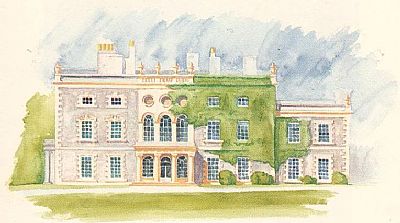NANTEOS
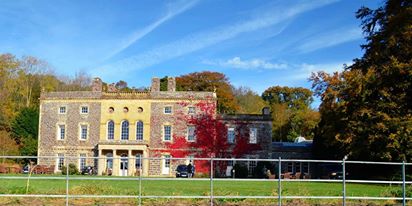
Nanteos (which means Brook of the Nightingale), a large, square, Georgian building, surrounded by the unspoilt beauty of the Welsh countryside, and lies in the Paith Valley, 3 miles from Aberystwyth. The site has a long history of occupation: an earlier dwelling known as Neuadd Lawdden existed there for many centuries before Nanteos was built. The present mansion being built in 1739.
Colonel John Jones, who raised the Cardiganshire Militia in support of King Charles I during the Civil War, was the earliest known inhabitant of the Nanteos estate. He had three daughters, Mary, Anne and Elinor. Anne succeeded on her father’s death in 1666.
Anne married Cornelius Le Brun, who was born in Cologne, Germany. He came over to Wales to work on the lead and silver mines as a mining engineer. After making his fortune later became High Sheriff of Cardiganshire in 1674. When he died in 1705, Nanteos was left to his only daughter, Avarina (1675-1728). She married William Powell (1658-1738) of Llechwedd Dyrus, which was situated just across the Paith Valley from Nanteos. William was the son of Sir Thomas Powell K.C. who was knighted by King James II in 1688 and was one of the Judges of the King’s Bench.
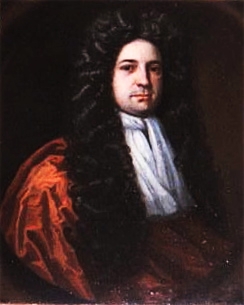
Sir Thomas Powell K.C.
THE POWELL FAMILY AT NANTEOS
William and Avarina Powell married in 1699 and settled at Nanteos, they had five children, Thomas, William, John, Anne and Elizabeth. When William died in 1738, the estate was passed on to his eldest son, Thomas, who immediately began to build the present house at Nanteos. He was married to Mary Frederick, granddaughter of Sir John Frederick (1601 – 1685), who was Lord Mayor of London in 1622 and it was her wealth that built Nanteos. Sadly, before completion of the mansion and while attending Parliament, Thomas died of an apoplectic fit in a London street at the age of 52. He had no issue though did have an illegitimate son who lived at Nanteos, though not much is known about him.
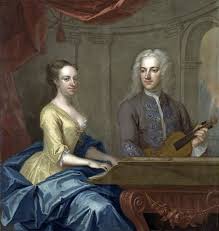
Thomas Powell 1699 - 1752, with his wife Mary.
Nanteos was left to Thomas’ brother, the Reverend William Powell, who took over the estate in 1752. William carried on with the building of the mansion, completing it in the late 1750s. His initials, W.P., can be seen on the lead drainpipe heads, dated 1757. He married Elizabeth Owen, eldest daughter of Athelstan Owen of Rhiwsaeson, Montgomeryshire. William was ordained deacon of Lincoln in 1731 and was made Doctor of Civil Law in 1763. He died in 1780 leaving a son, Thomas, and daughter, Corbetta Williamia, who married Colonel William Lewis of Llanerchaeron, Cardiganshire.
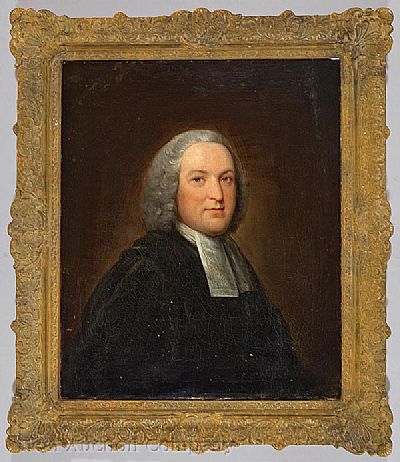
Reverend William Powell
1705 -1780
Thomas (1745-1797) married Eleanor Maurice Corbett of Ynysmaengwyn, Merioneth and became High Sheriff of the County of Cardiganshire in 1785. When he died in 1797, aged 52, the estate was left to his eldest son, William Edward, who was then only nine years of age too young to take over the estate. In the interim Eleanor took her four children to France and Nanteos was let out until 1809, when William Edward was old enough to take over the estate at the age of 21.
By 1810 William was High Sheriff and married Laura Edwina Phelp, eldest daughter of James Sacksville Tufton Phelp of Coston House, Leicestershire. They had two sons, William Thomas Rowland in 1815 and Cornelius in 1817. Sadly Laura died in 1822. In 1841 William Edward Powell marries for the second time to Harriet Dell, widow of George Achers of Moreton Hall, Cheshire.

William Edward Powell 1788-1854
William Edward Powell seems to have lived a double life! He had a long-term liaison with Miss Mary Selina Genet of Britannia Street, London, which spanned both his marriages. They had four children; Edward William (1816), Frederick James (1819), Henry James (1825), and Emma Mary (1830). William Edward Powell is named as being the father on all their baptism records.
Not much is know of their situation but Mary Genet and her family were well educated and provided for and it clearly states in William Edward’s last will and testament in 1853 that all the Genet family received £50 each. They later emigrated to New Zealand, where the descendants of the Genet family still live.
William Edward Powell died aged 66 and the estate was left to his eldest son William in 1854.
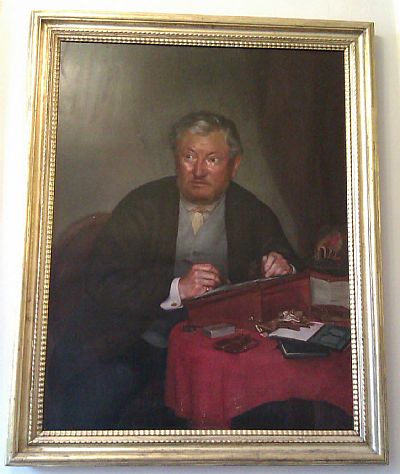
William Thomas Rowland Powell
1815 - 1878
William Thomas Rowland Powell married Rosa Edwyna Cherry, eldest daughter of William George Cherry of Buckland, Herefordshire, in 1839. They had a very rocky marriage, which ended in a nasty separation in 1854. They had two children, George born in 1842 and Harriet in 1844. Harriet sadly dies of consumption at the age of 13 at Nanteos. George never got on with his father, from an early age probably due to the treatment of his mother by his father. Being frustated with his son William Thomas Rowland presented his young son with a shot gun and told him to shoot the first thing he saw. He shot his father’s best prize bull.
William Thomas Rowland Powell was a Member of Parliament from 1859 until 1865, when he resign due to ill health. In later years he was confined to a wheelchair. In fact four wheelchairs were ordered at one time, presumably one of each floor at Nanteos and one for the outdoors. An annual event, which Colonel Powell orchestrated from his wheelchair, was the great battle that took place on the front lawn of Nanteos. Hundreds of people would gather, mostly servants and tenants, all following commands of Colonel Powell, waging a mock war on each other. He was also a keen artist and drew many humorous pen sketches while and around Aberystwyth, and on his travels to Nice, France and many other countries. He died in 1878 leaving the estate to his only son, George.
George Ernest John Powell, the most interesting character of the Powell family, was educated at Eton and then Oxford, where he met the poet Algernon Swinburne, his close friend for many years. George, himself, published a few poetry books, though he is most well-kown for famous publication of the Icelandic Translations in 1864.
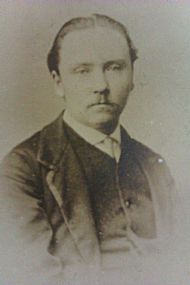
George Ernest John Powell
1842-1882
George was also a collector of many rare objects, books, and manuscripts, including volumes of Shakespeare, a fragment of Schumann’s coffin and many other strange and wonderful items, which he bequeathed his vast collection to the University of Wales, Aberystywth. George Powell attended the first performance of Wagner’s The Ring of the Nibelungs in 1876 and was later invited to dinner at Wagner’s home.
In 1878, after the death of his father, George returned to Nanteos to run the family estate. In 1880 he became High Sheriff of Cardiganshire, with a lavish ceremony in Cardigan. In 1881 he married Dinah Harris from Goodwick, Fishguard, where he had a cottage, but sadly dies a year later at Nanteos, childless at the age of forty.
George Powell had tried to establish a free library and art gallery at Aberystwyth which would have contained some of his personal collection but there was always much argument over its location and, ironically, on Tuesday 17th October 1882, at the very moment one of his fund raising concerts for the free library would have begun at Aberystwyth, he developed violent stomach cramp and died. Swinburne is noted for saying after the death of Wagner (who died 3 months after George), that George Powell had died and gone to heaven to announce the arrival of the greatest composer, Wilhelm Richard Wagner.
The estate was left to George’s cousin, William Beauclerc Powell (1834-1911), who inherited Nanteos in 1882. He married Anna Maria in 1864, who was the third daughter of David Lewis, of Bronavon, Cardiganshire, and had one son, Edward, born in 1870.
William and Anna Maria lived at Nanteos for over 30 years and died within days of each other in 1911 and Nanteos estate was left in the hands of their only son Edward.
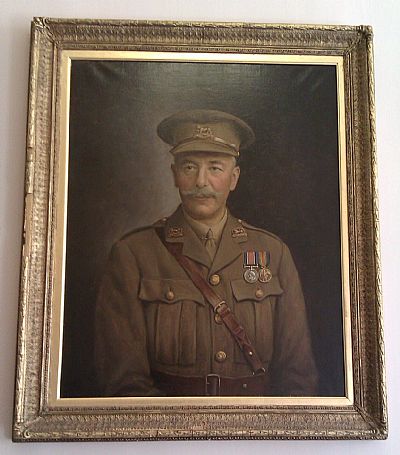
Edward Athelstan Lewis Powell
1870 - 1930
Edward Athelstan Lewis Powell (1870-1930) married Margaret Louisa Joan Pryse of Gogerddan, another large estate in Cardiganshire.
They lived in Rhydyfirian, just under a mile from Nanteos. They had one son, William, born in 1899. They bequeathed the Nanteos estate on the death of Edward’s parents in 1911.
Sadly, their marriage was scarred by tragedy. Their only son William (born 1899) was killed in action in Buvignies, France during the First World War on the 6th November 1918, five days before armistice. Nanteos was in full victory celebration when the telegram with the news of poor William arrived.
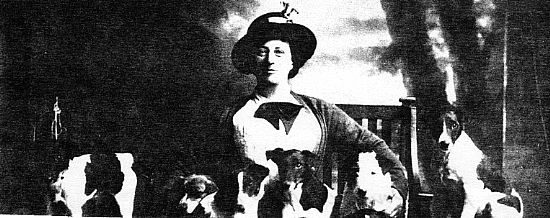
Margaret Louisa Joan Powell
1862 - 1951
With Edward Powell heavy drinking sessions Margaret Powell developed a close relationship with Lord Ystwyth (Matthew Vaughan Davies), of Tan y Bwlch, Aberystwyth. There was a flag-pole on the roof of Nanteos, and when Edward Powell was away or intoxicated, Margaret Powell would raise a bed sheet on the flag-pole, as an all clear for Lord Ystwyth to call. He would stay in the Blue room (now the Ystwyth Suite) on his regular visits. After the death of Edward Powell in 1930, she stayed at Tan y Bwlch each August, when Nanteos was let out fo the summer. After the death of Lord Ystwyth, at the age of 95 in 1935, she carried on with her August vacations, staying at 38 Marine Terrace, Aberystwyth, believing the sea air to be good for her health.
Margaret continued to live at Nanteos until her death in 1951 at the age of 89. She was a great character and would often be seen in the Milk Bar in Terrace Road, Aberystwyth on her visits to town, she was profoundly deaf and was always seen with her ear trumpet swinging on her arm
Guests calling at Nanteos would sometimes wait for over half an hour, while Maggie, the maid, would look for her (it was pointless calling her), and if she was unsuccessful in locating her, the visitor would have to leave and return at a laer date.
In the house if Mrs. Powell wanted to summons Maggie, she pulled a bell-pull at the bottom of the kitchen staircase. The bell would ring on the top floor. Mrs. Powell would place her hand on the banister to feel the vibrations. Then she knew that Maggie was on her way down to assist.

Margaret Powell in her later years in the Stables at Nanteos
In her later years, Margaret Powell, by then an elderly widow, chose to attend Moriah Chapel because Llanbadarn Fawr was too far to travel to attend St. Padarn Church. It is said that her pony would open the gate from the Nanteos back drive, while Mrs Powell snoozed in the pony trap.
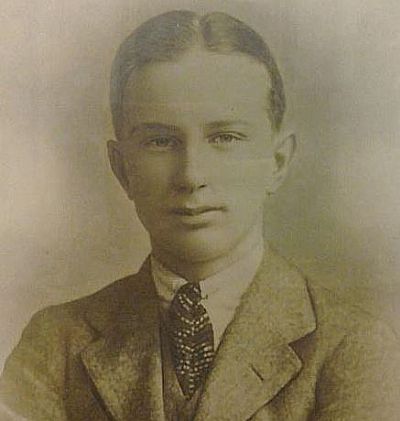
William Edward George Pryse Wynne Powell
1899 - 1918
A memorial to William E. G. P. W. Powell stands in South Gate, tohis memory, built and paid for by the tenants of Nanteos. It was unveiled by Lord Ystwyth in 1921.
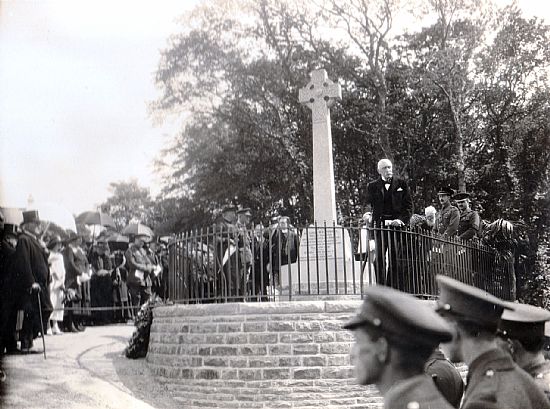
The Powells of Nanteos mentioned above are all buried at Llanbadern Fawr Church, 3 miles from Nanteos, near Aberystywth. Their memorial plaques are situated near the altar. Edward and Margaret Powell are buried unmarked in the same grave has his parents, William Beauclerk and Anna Maria Powell. Their son William E. G. P. W. Powell is buried at Maubeuge Centre Cemetery, France.
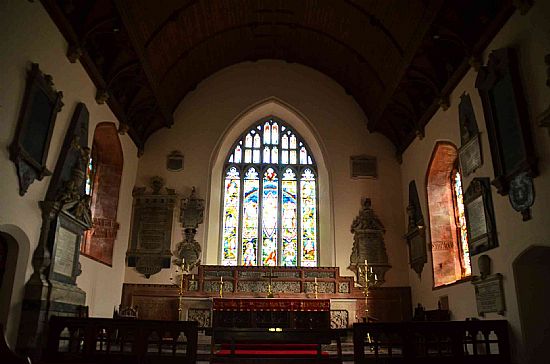
The Alter at St Padarn Church, Llanbadarn Fawr, Aberystwyth
The large window above the alter was erected under the direction of George Ernest John Powell's Will, in the memory of his mother Rosa Edwyna Powell, who died in 1860 aged 42 and his sister Harriet Edwyna Powell, who died in 1857 aged 15.
In her Will, Margaret Powell bequeathed the mansion and dwindling estate to Mrs. Elizabeth Mirylees, a distant relation of her husband. Major Mirylees, his wife and five children moved into Nanteos in 1956, but sold eleven years later. The new owners were Geoff and Rose Bliss and their two children, Tony and Michael. They opened Nanteos to the public as a stately home. Hundreds of people came through the doors during the sixteen years that they were open.
During the 1970s many television programmes were filmed at Nanteos. In 1983 they, in turn, sold the mansion. After the Bliss family, there were many occupiers, but today Nanteos is undergoing some major changes.
The House, Gardens and Staff
In all there were orginally 69 rooms, in the grand Georgian mansion. During the 19th century Nanteos had alterations done. William Edward Powell, (1788-1854) added new wings which included butler's quarters, housekeeper's quarters, a larger kitchen, and a portico (later his son added a billiard room). Various grand plans were drawn up at the time but due to lack of funds only the basic plans were used.
The main rooms on the ground floor are the Entrance Hall, Morning Room, Library, Dining Room, the Inner Hall, Kitchen and Billiard Room.
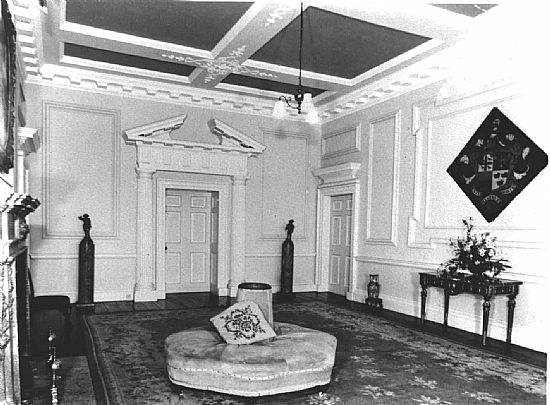
Entrance Hall 1970s
(Reproduced with kind permission of T. Bliss)
On the first floor is the grand Music Room, and the main large family bedrooms, with smaller rooms on the second floor.
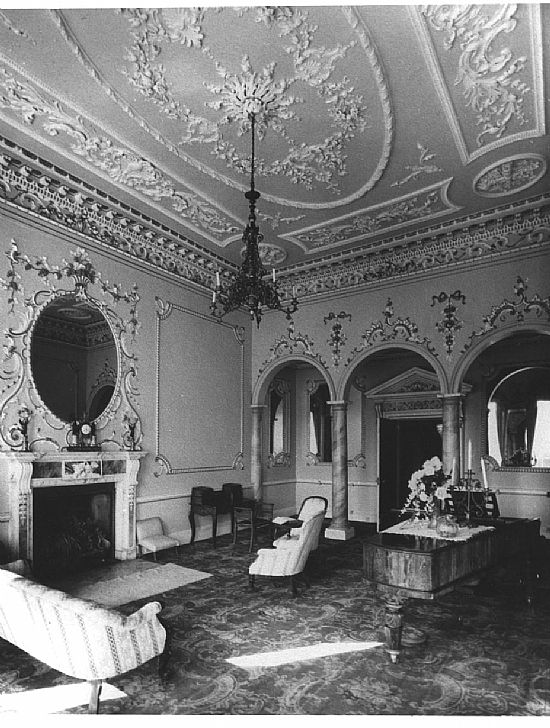
Music Room 1970s
(Reproduced with kind permission of T. Bliss)
The music room is one of the most lavish rooms at Nanteos with its Italian Aesop’s Fable fireplace and ceiling depicting the four seasons entwined with musical instruments. The mirrored walls enhance the decoration of the room. A Broadwood grand piano sat proudly in the music room for over a century. When George Powell purchased the piano he wrote to his father stating that no one was to tamper with it until he arrived at Nanteos. He practiced for hours for his public appearances with his special Broadwood. He had many famous musicians and poets as friends, including Wagner, whom George visited in German, but sadly Wagner never visited Nanteos.
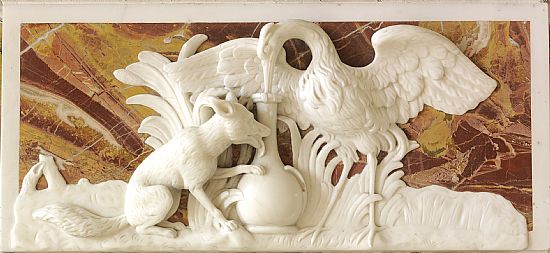
An Aesops Fable centre piece on the fireplace in the Music Room
Guests visiting the Powells at Nanteos were received in the morning room on the ground floor. Once a year the century old wallpaper was washed with bread containing no yeast. On the marble surround of the fireplace, there are a few marks that day be seen today. The story is that a servant girl was tending the fire when the butler walked in and jokingly pretended he was going to shoot her with a gun he was holding from the collection displayed in the next room. She screamed and fainted. As she fell, the gun went off and the shot scarred the marble.
The largest room in the house is the dining room (41 feet x 22 feet) on the ground floor. During the hunt and on other special occasions the room would seat over 100 people. Many parties and fancy dress party were regularly held during the Powell’s time at Nanteos.
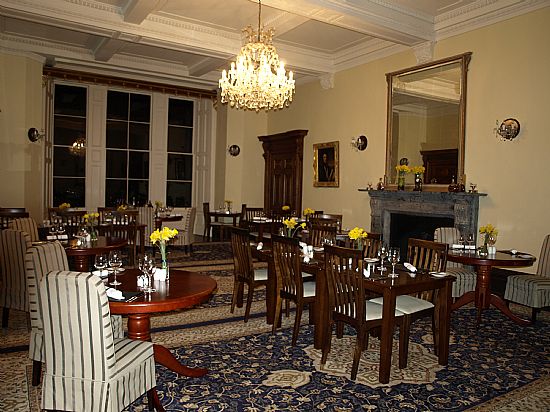
Dining Room
The cellar is located on the lower ground level and is roughly the length of the morning room, entrance hall and study, 60 feet in length. There is evidence here of an older house in the cellar suggesting that the Georgian mansion was built on the foundations of Neuadd Lawdden a previous house located on this spot. During the Powell time the cellar was full of wine, spirits and beer all labelled in their compartments. Beer was brewed in the brewery which was located in the outer buidling. In later years they grew mushrooms in the damp, dark cellar.
When the Powells went away or stayed at their London abode, it has been said that the servants held wild parties at Nanteos. The butler George White held the keys to the cellar, so the wine flowed! William Edward Powell got to hear of these parties and the key was confiscated immediately.
There was a peephole in the bathroom, on the first floor. The peephole was carved out in the inner door of the linen cupboard, which could be entered by another door in the corridor. Could the notorious Butler, George White, have made it? Employed at Nanteos during the mid 1800s, his time at Nanteos was certainly remembered. It is noted in the Welsh Gazette of 1905, that George White stated:
‘Nanteos ale both strong and stale,
Keeps my nose from looking pale’
When leaving Nanteos, George White asked Mrs. Powell for a reference. She abruptly wrote:
‘George White only stayed one night’
Recently, three unopened bottles of Champagne from the cellar still wrapped in straw were found hidden in the attic of the water closet in the butler’s quarters. He enjoyed more than strong ale!
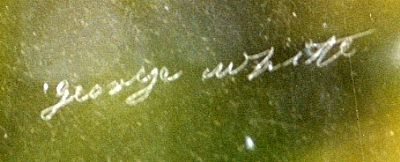
George White’s signature in the Butler’s Sitting Room
Today, the memory of George White still lingers at Nanteos. He etched his signature on a window in the butler’s quarters sitting room; he certainly left his mark.
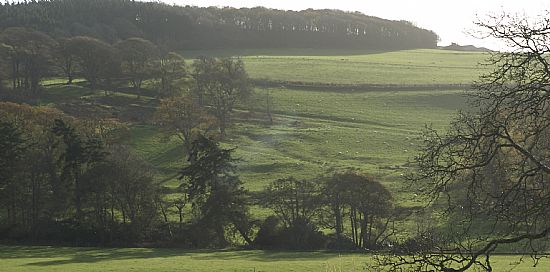
The view from Nanteos, showing old road marking.
Looking out in front of Nanteos one can’t help noticing scars in the landscape. These are scars of the original road that once cut through the landscape.
Countryside roads in the eighteenth century were in a bad state. An Act of Parliament in 1770 enabled the County of Cardiganshire to establish a Turnpike Trust, of which Powell was a member. Powell of Nanteos and Vaughan of Trawscoed, trustees of the Turnpike Trust moved the original road, in 1788 improving the road and giving the residence of the house more privacy, keeping the traffic away from the house.
The South Tollgate house, which was built by the Nanteos Estate in 1771 in Penparcau (2 miles west of Nanteos), the first Gatekeeper was David Jones, and was employed to guard the gate and take toll money for passing through. Tollhouses were unpopular with people who had to pay to travel and to move their livestock along the turnpike roads. There were various toll exemptions including – carrying materials for any road or highway; carrying compost or lime for manure; carrying hay, straw, or corn, passengers on horseback and to and from church or chapel, exemption also included the Nanteos family and servants, but they paid an annual one off payment instead. The Turnpike Trusts were abolished in 1864.The Tollgate House was moved brick by brick in 1959 to St Fagan's Museum of Wales in Cardiff, where it can be visited today.
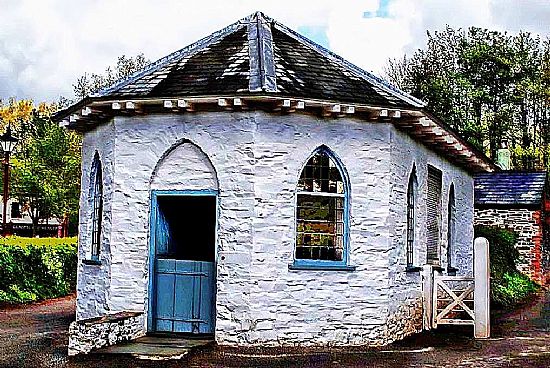
Southgate, Toll House now at St. Fagans.
Christmas
Every Christmas a large Christmas tree from the estate would be placed in the Entrance Hall.
In the inner hall on the main stairway holly with berries from the estate would have been weaved round the bannister, all the way up the first floor.
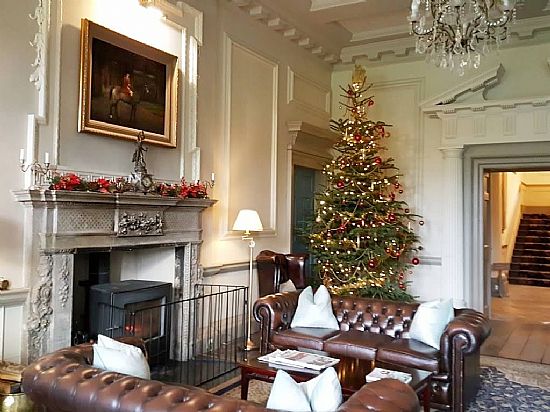
Christmas Tree in the Main Entrance Hall
The Christmas room was situated on the second floor, the furthest room from the stairway. The second floor was closed off during the cold winter to conserve heat, although entry was possible through a side room near the stairway. But it was opened up for Christmas and the Christmas room decorated with Christmas cards all over the walls. A stack of coins were placed by the front door for children to call and sing for ‘Calennig’, (Calennig is a tradition of giving money to children in the New Year after they sang a song or two). Carol singers were giving four shillings and even beggars calling were given a few shillings.
In 1940 Margaret Powell received a telegram on Christmas Day from her brother Lewes:
‘Oh Missie Dear,
I greatly fear
Of cards I have none
I wish to you
And servants too
Good luck and lots of fun ~
Lew’ (Gogerddan)
Servants and labourers were treated with ale at Christmas. In 1910 the bill for ale in December came to £63.8s.6d. December was a busy time of year for the servants and Christmas day was the busiest day of all, with the preparations for the Boxing Day hunt, there was no rest on Christmas Day. A turkey was bought from Cefn Llech farm. A pig that was kept in the Dove Cot was killed, half the pig was pickled for the following year; the rest of it was eaten during the festivities. Other meat came from Scotland and a hamper arrived from Harrods, containing ham, silverside, tea and other treats. Other foods cooked for Boxing Day Hunt were game pie, rabbit pie, roast turkey and beef, boiled ham, meringue and a large pot of rice boiled on the fender. With the return of the hunt on Boxing Day, late afternoon, well over a 100 people gathered at Nanteos, hungry after their day of hunting. Half sat in the dining room and the other half in the servant’s hall. Many followers of the hunt were also invited in, many children from the surrounding villages, helping themselves to turkey sanwiches and a cheeky glass of beer when no one was looking.
Cook’s Cawl
2 tbsp. lard dripping
2 large onions, thickly sliced
2 medium swede, peeled and cut into 1" cubes
6 large carrots, peeled thickly sliced.
4 leeks, cleaned and sliced
2 lb potatoes, peeled and quartered
2 lb brisket of beef
Pale Ale, one pint
Parsley, chopped
Sprig fresh thyme
Large pot of water
Salt
Simply boil all ingredients in a large pan until tender; then serve with bread and cheese. Best served hot the following day.
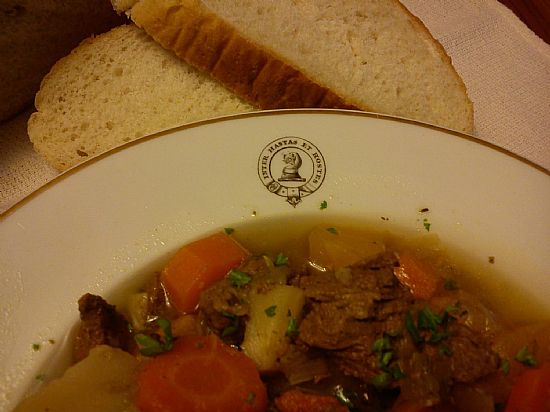
Cawl in a Powell’s crested soup bowl
With all the Christmas entertaining of friends and family the estate workers were not forgotten. Workmen of the estate would be annually invited to a party held at Nanteos where they would be given their Christmas bonuses. Workers would sing songs and recite verses for the hosts, and at the end of a jolly evening the workers of the estate would be given a substantial Christmas box containing groceries and meat. And to close the evening’s entertainment ‘For he’s a jolly good fellow’ was sung to Captain Powell, and good health and happiness to all.

Nanteos Stables 1927
The stable yard, situated behind the mansion, built in Roman style architecture in 1837, by William Coulthart. An ornamental cupola stands on top of the west end roof. On the arched entrance there once stood a bronze horse sadly sold in the 1950s and two stone eagles, were sold in the early 1980s.
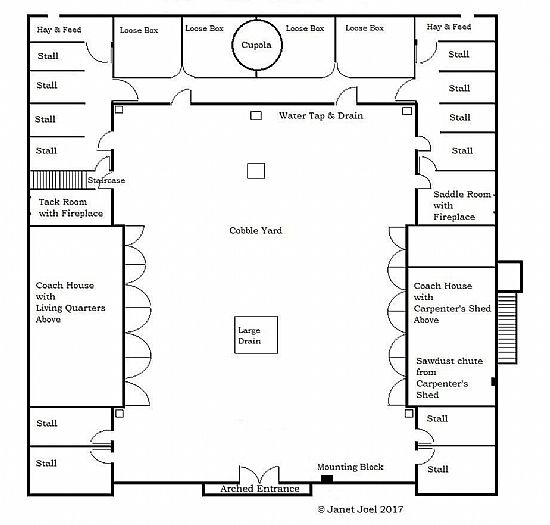
PLAN OF STABLES
The stable has a cobbled floor and bays that hold up to 18 horses. There are eight large entrances for carriages, which held Two Victorias, a Phaeton, a Brougham, a Station wagon, and in later years a Model T Ford with the number plate EJ 1071, sadly gone many years ago. The smaller doorways lead to the stable bays, tack room and saddle room. Above the carriage compartments were the living quarters for the stable staff on the right side and on the left side was the Carpernter’s workshop.
The day began very early for the stable staff. They would regularly spend a week scrubbing the cobbled stable yard with boiling water until it was spotless. During the hunting season work would begin at 4am. preparing the horses for the hunt. The hunt lasted most of the day; going as far afield as Bow Street and Trawscoed, then back to Nanteos for food prepared by the kitchen staff.
For the kitchen staff, the day began at 6am with the preparation of breakfast for the outdoor staff at 7am. The outdoor staff were called in by a bell, which once stood in a tower by the courtyard. Sadly, the tower has long gone, as is the game larder that stood 15 feet high in the courtyard until it was demolished in 1971 for safety reasons.
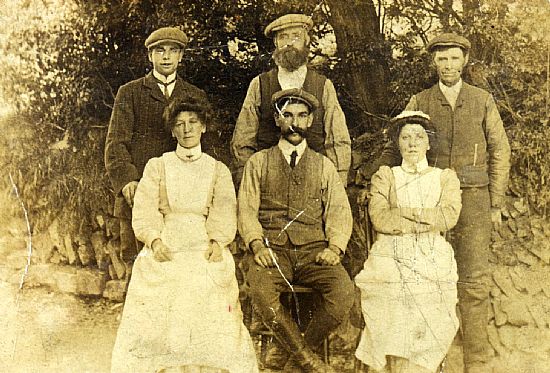
Servants at Nanteos (1905)
Back Row – Charles 2nd Coachman, Henry Joel, Evan Griffiths of Dyffryn Paith
Front Row Ellen Rowantree, Jim Williams,
Mary “Oit” Davies
Wages at Nanteos in the early 19th century
Valet £50 per annum
Butler £40 per annum
Cook £30 per annum
Groom £20 per annum
Housemaid £16 per annum
Kitchen maid £16 per annum
Stable boy £11 per annum
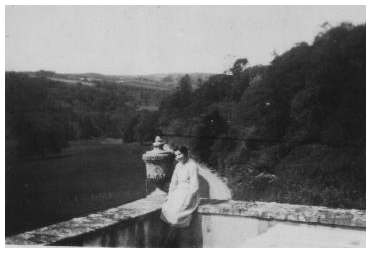
Maggie Williams on the roof
Numerous members of staff passed through Nanteos throughout the centuries. Maggie Williams the maid began working at Nanteos in the early 1920s, at the age of 14 and stayed until the late 1950s when the Powell line came to an end. Her mother Mary ‘Oit’ Davies also worked at Nanteos and they lived in the stables apartment. Oit worked outside feeding and preparing the horses. Maggie worked for Mrs. Powell in the house doing all chores, including repairing holes in the leaking roof.
During the 1800 and 1900s the large estate had many working hands; and domestic life at Nanteos was hectic. In the 1920s 10 members of staff worked outside; 3 in the stables, 2-3 in the walled garden, 3 in the sawmill and there was also a carpenter.
Towards the end of the 1930s Maggie was the only member of staff in the house and would clean from top to bottom. During the summer months extra staff were employed for the annual spring clean.
Servants’ quarters were on the third floor, which was demolished in the late 1950s to make way for a new lead roof.
The Walled Garden
The 2.185 acres walled garden, surrounded by red brick and stonewall, with its four greenhouses and a glorious vinery (built 1893) the garden once flourished with colour. Gravel paths flowed around the beds. Originally the garden had seven entrances leading in from all corners of the estate and kept lock during the night.
An underground boiler heated all the greenhouses, which grew peaches, melons, figs, artichokes and asparagus, as well as all the usual vegetables and fruit. Supplying everything that the kitchen staff could wish for. Suplus stock would be sold to the staff and tenants. When work had finished for the day, all doors were locked and the key was kept in the yew tree, at the entrance nearest the house.

1927 Potato Harvest at Nanteos
Back row: David ‘Johnnie’ Evans, Mary Davies, Dick Jenkins
Front Row: Mabel Knight, David Scott,
Dick Hughes (Moriah), Tom Jenkins and William Davies (Boy).
In the early 1930s, after the death of Edward Powell, the garden began to deteriorate. Then, by chance in 1936 Reg Newman from New Castle Emlyn, came to hear of the garden being put out to let. He moved into the Lodge at Nanteos (then later to the Woodlands) and transformed the garden back into its former glory.

Land Army Girls sitting with Margaret Powell
At the outbreak of the Second World War, with the help of all the staff and Land Army Girls, two front fields of Nanteos were turned into crop fields of cabbage, Cauliflower, Brussel sprouts, lettuces and potatoes. One year during the war, the whole country suffered with a plaque of caterpillars destroying all crops. Mr. Newman came up with a solution of ‘sheep-dip’ to treat the effected crops, which immediatley cleared all the caterpillars. He sold onions under the clock tower at Aberystwyth and made one hundred pounds in one day. He also sold to many other needy places as far as Birmingham.
During the Second World War nuns stayed at Nanteos. They were evacuated from St. Margaret’s Bay in Kent, in 1941 and lived on the second floor of the mansion. The room in the centre of the second floor was used as their chapel. The Canon accompanying them slept in a first floor bedroom.
During this time, Reg Newman moved from the Lodge to a larger house of the Woodlands, east of Nanteos. But while living at the Lodge he would travel to work on his bicycle very early in the morning and the Canon would scare him half to death by jumping out of the woods in his white robe. The Canon also accidentally set fire to the chimney in his bedroom while staying at Nanteos.
The nuns made various remedies from various plants that grew around the lake, walled garden and near the Buildings Home Farm.
Today, the walled garden is being renovated. The original pathway have been reinstated and the apple trees and cherry trees are being replaced. The greenhouses and vinery will be renovated in time. Only four entrances remain of the walled garden, one of which has been enlarged for modern day tractors. Reg Newman left Nanteos in 1948 and became a very successful grocer in Aberystwyth for many years.
The outer part of the east wall of the walled garden is the shrubbery. Once paved with gravel and full of beautiful and exotic plants. There was also an aviary. Half way down the shrubbery is a pets’ grave yard, dating back as far as 1865*
One of the head stones in the grave yard, adapting part of the ‘To be, or not to be’ speech from the Third Act of Hamlet, Prince of Denmark, reads:
"Traveller
A favourite retriever
That undiscovered Country from whose borne
No traveller returns."

Pets’ Grave yard in the shrubbery
Beyond the pet’s grave yard is a newly constructed Labyrinth to be enjoyed.
During the 1930s and 40s a white Malaccan Cockatoo terrorised the staff of Nanteos, especially if they were wearing Wellington boots! He was named Stuart lived in and around the courtyard, and would lie in wait for an innocent by passers and then pounce on his victim. He originally came from the Buildings (Nanteos Home Farm). His favourite food was scrambled egg, but flew in rage when given porridge. He is also buried in the pet’s graveyard.
Horses were a very important issue at Nanteos. Many favourite horses are buried in the wood, but having said that, several horses were slaughtered and fed to the hounds.
*Stones in the Pets Grave yard: Traveller 1865, Grandeur 1929, Rags, Hermit, Old Curate, Roman, Vagrant, Gin, Pet of Pets, Mayfly, Prince, Bellman, Poor Jack the coon and Jenny his wife, Playmate, Penelope, Jack, Pilgrim, Nelson, Sponge, Restless, Rufus, Trim, My White Muff, Fan (stone missing), Freckles (stone missing) Mooney 1925 (wooden plaque with poem, missing), Lady (unmarked) and Stuart (unmarked).
The hounds, namely the ‘Nanteos Harriers’ were housed in the kennel’s on the front lawn, it’s original size and shape is not known, but was of architectural design, and now stands in ruin. What is left of the building can been seen from the front of the mansion across the Paith valley south of Nanteos. In 1865 the hounds where moved because the dampness of the marshy ground that caused the dogs ill health. They were moved to a smaller domain east of Nanteos with improved access, plus a loft space for the handler to sleep. In 1865, 80 hounds made up the ‘Nanteos Harriers’. Most of the name began with P (for Powell).
The old kennel ruin was once used for target practice. A large wooden plank with a bell in the centre was nailed to the ruin. Everyone, including the servants, would gather outside the front door of Nanteos, using pistols, would aim at the target. If they shot a bull’s eye, the bell would ring and the lucky contestant would have a tot of whisky as a prize. Margaret Powell, not being a good shot, used a small cannon.
Coming up the drive towards nanteos, surrounded by lush trees, is a large lake with an ornamental island in the centre. Two dilapidated boathouses stand at the far end. During the Powell period the lake was kept in pristine condition with regular maintenance. Two boats rowed around the lake in tandem with a sharp blade between them to cut all the lilies, plants and weeds. During the freezing winters, ice hockey would have been played on the lake.
Across the drive from the lake is a bridle path that begins at the mansion and ends up at the lodge. There are many other paths through the woods but this is the most glorious.
Myrtle bushes grow along the front wall of the mansion. Sprigs were taken from the bouquet of every Powell bride at Nanteos and were planted near the windows of the mansion, and they still thrive today.
On the front lawn of Nanteos, below the large two beech trees once laid the tennis court surrounded by a high fence. An Ayres Patent Championship tennis post held the tennis nets. Maggie Williams’ brother William was the all-important boy-ball every August when the Burman family from Birmingham rented Nanteos for their annual holiday during the 1930s. They would travel to Nanteos in a bus together with over 20 guests. One year the Lord Mayor of Birmingham (an uncle of the Burmans) travelled to Nanteos in his Rolls Royce. One of the maids that came with them to Nanteos fell in love with and married the carpenter, Vernon Rowantree. They lived at Nanteos, and then later moved to Piccadilly Terrace, Penparcau.
Nanteos Cup /Cwpan Nanteos
The Holy Grail, a small fragmented vessel also known as the Nanteos Cup or Cwpan Nanteos, said to be The Holy Grail used by Jesus Christ in the last supper.
It is said that it came to Nanteos with seven monks from Strata Florida, Cardiganshire, on the dissolution of the Abbey in the reign of Henry VIII. The abbey disbanded in 1539 and it believed that seven monks escaped from the Strata Florida Abbey together with the Cup and fled to Nanteos, where they stayed. When the last monk passed away and Cup was left in possession of the Joneses of Nanteos. The sacred vessel was kept safe for many centuries at Nanteos. It is said that the monks are buried near the two beech tree in front of the mansion that stand majestically today.
Through marriage the Powell family took over the Nanteos estate in 1699, and the history of this Cup begins to evolve into a Healing Cup where people were cured of their ills by drinking from it. However, it is many years later it makes a first public appearance. The Nanteos Cup was put it on display at the college of St. David’s University of Wales, Lampeter by George Powell where it was displayed in a ‘Cambrian Archaeological Society ‘exhibition in 1878. From the onset of its first public display, word of its power as a Healing Cup began to spread; it was displayed quite regularly in various local meetings and lecturers etc.
George Eyre Evans an antiquarian and local historian living in Aberystwyth at the time became very interested in this vessel and with regular visits to the Powell family at Nanteos organised a public event. A tour of Strata Florida Abbey and Nanteos in a charabanc was arranged by George Eyre Evans with the Chautauquans (an Adult Education movement). The visit was planned in 1901, and a small photograph Album of the event can be seen at the National Library if Wales. (NLW Photograph Album 240a). Ethelwyn Mary Amery, one of the members of the movement, wrote Sought and Found: A story of the Holy Grail, in 1905, giving the history of the Holy Grail and it origins. So impressed the Powell family were by Miss Amery’s visit to Nanteos one of the room on the second was name after her.
George Eyre Evans certainly popularized the Nanteos Cup and word spread of its powers. Correspondences kept in the Nanteos Archive Collection at the National Library of Wales shows the great interest it generated worldwide.
The Nanteos Cup was lent out to many localised exhibitions – here is one example -
4 August 1916
Cambrian News
PENPARKE THE HOLY GRAIL.—Cwpan Nanteos, kindly lent by Mrs. Powell. Will be on view at the exhibition at Penparke National School next Tuesday afternoon and evening in connection with the patriotic sale in aid of the Sailors and Soldiers Fund organised by the Women's Sewing Circle. The sale will be opened at 2.30 by Dr. Roberts, Penywern. There will be several interesting features, including the Aberystwyth war book containing items from the weekly papers, portraits, prints, etc., since the declaration of war. There will also be historical articles from the homes of Vicar Pritchard, Williams Pantycelyn, arranged and explained by Mr Geo. Eyre Evans.
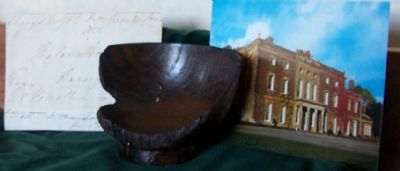
With the public appearances and publications etc., by the 1920–30s the Cup came very well-known.
On the 15th January 1930, The National Library of Wales borrowed the Nanteos Cup, for an exhibition. The Cup was carefully wrapped in a rug and placed in the safe hands of Maggie Williams, the housekeeper and taken from Nanteos. David Walters, the groom, took the quietest pony to pull the cart to take Maggie and the Cup to Hen Cwrt, the home of the Librarian, Sir John Ballinger. Sir Ballinger would be responsible for the Cup while it was away from Nanteos.
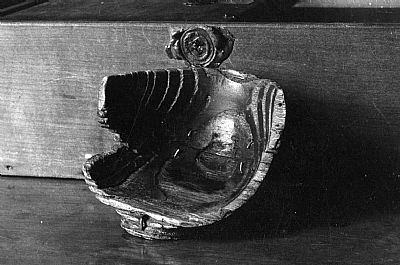
The Cup now measures only 10cm by 8.5cm is held together by wire staples and fits comfortably in the palm of the hand.
People from far and wide came visiting to Nanteos to drink out of the Nanteos Cup. Margaret Powell had a routine to the Cup lending, which was as follows:
The Cup was kept in the library at Nanteos, and kept locked in a cupboard. The Cup that was on display was a replica made by Richard Rees Jones of Rhoserchan, Isaf, Capel Seion. The visitor that wanted to drink from the Cup would be sent into the Morning room to be greeted by Margaret Powell. Maggie the Housekeeper would be in the Library placing the genuine Cup on display instead of the replica and put on display on the table between the two windows. She would fill it up with water, and then Mrs. Powell would enter the library from the morning room with the visitor. The visitor then drank from the Cup. After the water was drank Mrs. Powell took them into the dining room and slammed the door loudly so Maggie could hear. Maggie said that once she heard the door slam she would then take the Cup, dry it and then replace it with a replica in case anyone tried to steal it, then replacing the real Cup in the locked cupboard. She said that this was done every time when a visitor called.
Tstimonies of healing powers of the Cup can be seen in old receipts here are just a few examples -
27th November 1857
Cup loaned this day to Wm Rowland Ystrad Tregaron for his sister ......wholly cured left one pound returned 2nd January.
May 1858
Cup lent this day to Evan Evans Pantyfynnon ……… left a watch.
26th July 1860
Cup lent this day to James Morgan....... Left a sovereign.
20th January 1860
The Cup lent this day to Rich Jones Labourer, Llangonsen for the use of his wife ........... Left a watch, bleeding stopped. Returned 7th March 1860
3rd August 1862
The Cup lent to Wm Jones Llanbadarn ...... left silver watch. Returned 4th September 1862. Case cured.
With the selling of the mansion in 1967, the Nanteos Cup left Nanteos and taken to Ross on Wye, where it stayed, while still being used to heal the sick.
In July 2014, the unthinkable happened; the Nanteos Cup was stolen, and made International news. While its owner was in hospital someone broke into their home and stole the Cup. For 11 months the Cup’s whereabouts unknown, then miraculously the Cup was handed to the police in Herefordshire. The scared vessel was handed over to the police and no arrests were made.
Today, a new chapter begin with the Nanteos Cup. The Cup returns to the National Library of Wales for safe keeping, and is on perament display for all to visit.
Nanteos have created their own Nanteos Cup monument to commemorate the connection of the sacred vessel seeped in history. Passing the small cemetery the stone Labyrinth cam e be found. At the centre stands the Nanteos Cup of stone. Local craftsmen Bob Shaw and Ed Harrison have come together and by using their knowledge on ancient craftsmanship and traditions have enthusiastically constructed this labyrinth using local stone.
This representation of a sacred vessel is located at a secluded area of the shrubbery near the walled garden at Nanteos, away from the mansion for tranquility, spirituality and peacefulness. This once manicured area of the shrubbery is the perfect place of peacefulness.
GHOSTS
The Lady in Grey
I visited Nanteos one day
And I went to the lounge to wrong way.
As I turned back ,A voice said “Hello Jack”,
And there stood the Lady in Grey.
She said “Don’t be scared Come with me,
Sit down on the velvet settee.”
Before I came out I had a bottle of stout,
A chat and a nice cup of tea.
But the lady so charming and gay
So suddenly vanished away: I shall never forget
That beautiful Lady in Grey.
Jack Oliver
(This poem is reproduced with the kind permission of the family of The late Jack Oliver)
Nanteos with its long dark corridors and large imposing room does attract the mind to think of ghostly thoughts, and Nanteos does not fail, in that respect.
Firstly, we will discuss the ghosts that haunt the grounds of Nanteos, we begin in the woods. On a still peaceful night, Gruffydd Evan can be heard playing his beloved harp deep in the Nanteos wood. Every Christmas the highlight at Nanteos was Gruffydd Evan's playing beautiful harp. Every year for 69 Christmases he played in the Music/Salon Room (he was known as the Official Harper to the Powell Family). He was a relative of the Powell family and lived to a grand age of 92 and is buried at Llanbadarn Fawr Church, near Aberystwyth.
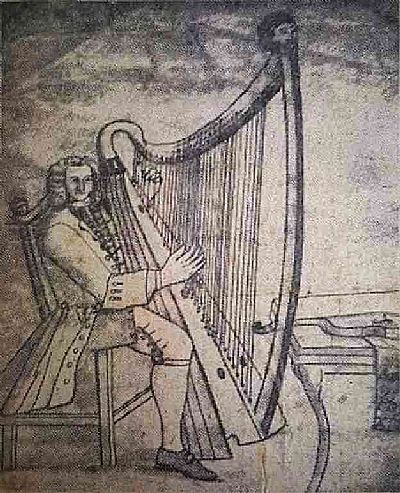
Gruffyd Evan the Nanteos Harpist
The Stable yard at Nanteos has been a hive of activity for centuries and horses and voices have been heard in the stable yard. On two consecutive nights at about 4.00am, voices were heard in the yard, but as soon as the listener looked, the noise
abruptly stopped. A baby has also been heard crying in the Stables Apartment on a number of occasions. Also horses have reacted nervously to something the horse handler couldn’t see.
Another ghost that can be named
is that of William Griffiths the Groom, who was killed by Rice Walters the Head Gardener by a garden rake on 12 October 1782, occasionally he can be seen standing in the shrubbery, as if waiting for someone.
On another occasion a horse and carriage was heard in the Court Yard at the back of the mansion. Then heavy footsteps were heard entering through the back door, and walking towards the kitchen, dragging what sounded like heavy chains.
We will now venture in the mansion where many apparitions have been witnessed.
There are numerous ghost stories associated with Nanteos. The most well known haunting is Elizabeth Owen (The Grey Lady), wife of Reverend William Powell, who lived at Nanteos during the mid-1700s. Her husband dearly loved her and showered her with jewels. She could not bear to be parted from her treasured jewelry and dreaded to think what would happen to them after her death. Knowing that she was dying, she rose from her deathbed and hid her jewels. Later that night she died, and now it is said that her ghost haunts to corridors of Nanteos searching for them, her ghost, shrouded in a long flowing gown, still wanders like a lost soul searching for her hidden jewels. BE WARNED - she will haunt anyone that dares to find her treasure.
In the 1800s a young nursery maid, Mary, who was had been working at Nanteos for 6 months had to sleep in the Pink Dressing Room as the mistress of the house was sick in the next room. One night Mary was suddenly awakened by a figure leaning over her bed. Startled by what she saw she screamed. The figure then stood upright and walked straight through the closed door. Mary never slept in that room again.
This is very similar the story of two American ladies staying at Nanteos in the 1920s. One stayed in the Pink Room and the other stayed in the Damask Room. After going upstairs to dress for dinner there was a commotion. The lady in the Pink Room ran out and crossed the corridor carrying her belongings to her friend's room shouting "I'm not gonna stay in THAT room". However, she never revealed why.
A young girl read to Margaret Powell every night at her bedside in the Macaw Room until very late. Edward Powell warned the girl to leave at 11:30pm, never to stay until midnight. One night she did read over the specified time, realizing this she ran downstairs, on the stairs to her disbelief she saw a ghostly figure, she screamed and fell in a faint down the stairs, hitting her head on the grandfather clock at the bottom. Edward Powell who was sleeping in Col. Powell’s bedroom rushed to her side on hearing her screams. After checking see was all right, he told her never to speak of this ghost that she had seen. She was confined to her bed for three weeks after her fall. She never spoke of the incident until many years later.
Parties were (and still are) held at Nanteos. One evening the house was full of
guests, an army officer present went to dress for dinner. Ascending the stairs to his room, he met a striking woman in evening dress, holding a strange looking candlestick. Thinking she was one of the guests, he bowed and bade her good evening. The lady did not answer but carried on down the stairs as if she had not seen him. He thought it strange but continued up to his room.
On returning to the party, he gazed around looking for the lady. Eventually he asked if anyone has seen this woman. Immediately, he was taken to one side and told never to speak of the lady with the candlestick or there would be a death in the family. THAT NIGHT A POWELL DIED. A couple of weeks later the very same strange candlestick was found in a dusty disused -top shelf corner of the Silver Vault room, in the Butler’s Pantry.

A tilting chair has recently been seen by numerous people, in one of the bedrooms, when approached the chair will either fall back on its four legs or topple over.
The most eerie sighting at Nanteos was a sighting seen from the front door, and was that of what was thought to be smoke in the inner hall. The witness stared in disbelief as the smoke transformed in a figure of a woman dressed in a long flowing dress. She began coming towards the front door through the Entrance Hall, terrifying the onlooker so much that he ran to Aberystwyth, not daring to look back.
There are noises in most old houses, whether it is just a door slamming or the wind howling. A lot of rumblings have been heard since the hotel has opened; noises, which sound like moving furniture being dragged on the floor, all these noises are heard through the house on all floors and are still unexplained.
Recently, a gathering of people has been heard, the sound of the voices was carried up to the first floor. Thinking they were visitors in the entrance hall, the witness, half-asleep thought no more, until morning when someone else had heard the very same voices, and stated that the time was 3:45am and that no one was visiting the house at the time of morning?
A young girl aged about 7 - 8 years has been seen running through the kitchen, and “Hello Cook” was heard, chef gave chase and she disappeared, when he asked the whereabouts of the girl, to the kitchen staff no one else had seen her. Two other members of staff have seen a shadow of a small child in the kitchen area at different times. Who this ghostly child is remains a mystery.
One night the Night Porter was seated in the Entrance Hall and could hear marbles or pebbles being rolled in the Inner Hall on the stone slab floor and then continued to roll onto the wooden floor going into the Library, as this rolling continued, he check to CCTV cameras and saw nothing so he walked into the Inner Hall from the kitchen door, hoping he’d catch someone rolling them into the Inner hall but saw no one, he turned on the lights and there was no evidence of marbles or pebbles on the floor.
Sometime during the mid-1970s, a lighted candle had been left in the entrance hall window, next morning it was found in an upstairs bedroom with the flame blown out. How is got there no one knows.
A Newspaper reporting of ghostly going on at Nanteos is an incident in the early 1980s when a television company was making a production for a Welsh film company S4C. It was reported in the Western Mail that a two-day filming schedule was disrupted by ‘strange experiences’ - doors opening and closing, on their own accord. A broken musical box suddenly started playing, movement of a heavy four poster bed and it is believed that a cloaked figure disrupted a video unit sent to shoot several TV scenes here to such an extent, the crew refused to work after dark. Sian Phillips one of the actresses involved said that she would not doubt the supernatural again.
During the early 1990s, the mansion was empty but was managed by a caretaker. Permission was granted for the Fire Brigade and Police Force to train in the empty house at regular intervals. The Police would train their dogs, to retrieve hidden substances throughout the house including the cellar, hardened police dogs trained to deal with all sorts of dilemmas, were nervously cowering and whimpering at the top of the cellar door and refusing to enter.
Nanteos is now a grand hotel, and there has been many unexplained happens going on, hopefully the spirits of Nanteos, will not frighten too many guests away, and they are only there to make sure that all is well at Nanteos.
The Powell family ran the Nanteos estate for 252 years, the last Powell lived until 1951 at Nanteos, since them Nanteos has had several ownerships. Today, Nanteos is owned by Shane and Carolyn Lipscombe and, after much restoration in keeping with its historical origins, the mansion being run as a luxury hotel and restaurants. Its setting and grandeur have also attracted the film world as an ideal location venue, and many a happy wedding receptions has taken place here. It also has a conference room and is available for many varied events, including an annual Nanteos Summer Fete.
2017, with further renovations Nanteos is now a 21 en suite bedroomed hotel. Now fully restored from top to bottom. With a treatment rooms for pampering sessions with two restaurants and public bar.
Once again this grand old mansion is full of life.


Crest of William Edward Powell 1788 - 1854
Snippets of History at Nanteos
1644 - The Cardiganshire Militia was raised by Colonel John Jones of Nanteos
1675 – Ty Mawr in Pier Street Aberystwyth, which was owned by the Pryses of Gogerddan, was let to Thomas Powell of Llechwedd Dyrus.
1687 – Thomas Powell was knighted (Knighthood fees £86.11s.6d.).
1739 – A foundation stone was laid on the east side of Nanteos: ‘This stone was laid 3rd May 1739 by direction of Thomas Powell and Mary his wife”.
1745 – Thomas Powell inherited the whole Strata Florida Estate after the death of his brother in law, Richard Stedman. By the end of 1745, Anne Stedman had remarried to Herbert Lloyd of Peterwell.
1748 – Thomas Powell gave £50 to help with restoration of Cardigan Church.
1753 – Herbert Lloyd of Peterwell and William Powell of Nanteos, who were both magistrates, led an armed mob of several hundred people to Esgair Mwyn mines, held a pistol to Lewis Morris’ head and invited him to transfer possession of the mine. Shaking with fear, Morris sumitted and was incarcerated in Cardigan Goal for six weeks.
1770s – Strata Florida was sold by the Nanteos Estate.
1770 – The Tollgate House in Penparcau was built. Taken down brick by brick in the 1950s and now stands in St. Fagans, Museum of Wales, Cardiff.
1788 – The College Theatre, Aberystwyth was under patonage of the Powells of Nanteos.
1788 - 5th February, Jenkin Joel was paid £4.3s.2d. for some masonry work done in the kitchen at Nanteos.
1797 – 16th April, Thomas Powell died aged 52. His wife Eleanor Powell had a mourning ring made, The gold and enamel mourning ring inscribed THOS. POWELL Q.B. 16tth April 1797
1800 – The Nanteos Estate totalled 31,000 acres.
1809 - Accidental death of gamekeeper, shot during a hunt
1807 – William Edward Powell graduated from Christchurch, Oxford.
1810 – 4th October, marriage of William Edward Powell to Laura Edwina Phelp.
1812 William Edward Powell was stationed in Ireland with his regiment.
1815 - 4th August, William Thomas Rowland was born in Swansea, first son of William Edward Powell.
1816 – 24th August Edward William was born in London, first illegitimate son of William Edward Powell
1817 – 7th July, Cornelius was born in Swansea, son of William Edward Powell.
1819- 19th August, William Thomas Rowland and Cornelius Powell were christened at Llanbadarn Fawr Church.
1829 – January, pair of pocket pistols to be given to the gamekeeper as there is much poaching.
1820 – 13th September, Mr Richard paid £1.1.0 for tuning a piano for Mrs Powell.
1821 – The eastern part of the Cwmystwyth mines were leased by the Nanteos Estate.
1821 – 31st July, 27 days weeding of garden at Nanteos 1May – 31st July £1.11.4 paid to Evan Morgan
1822 – 8th September, Laura Edwina (Phelp) Powell died aged 35
1830 – The Nanteos Estate totalled 21,900 acres.
1834 – William Thomas Rowland Powell was in Jamaica with his regiment.
1837 – The bill for ale given to the Nanteos labourers on the Coronation of Queen Victoria came to £4.16s.0d.
1839 – William Thomas Rowland Powell returned from his regiment with the rank of Captain to marry Rosa Edwyna Cherry.
1840 – Richard Owen Powell became Mayor of Aberystwyth.
1840 – Fire in the servants’ hall at Nanteos.
1843 – Lovesgrove estate was sold from the Nanteos Estate for £7.500 to John Evans.
1847 – The portico and new wing were completed at Nanteos.
1854 - William Edward Powell died aged 66.
1859 – The present Lodge at Nanteos was built by the architect D. Kyrke Penson.
1861 – 30th March, Margaret Evans and others were paid £1.5s.0d for spreading dung over the lawn for 30 days.
1861 – 2nd July, Robert Williams was paid £0.14s.8d. for catching 92 moles in the lawn and about the shrubbery.
1863 – George Powell went to Iceland for six months.
1864 – Trees from the Nanteos woodlands were planted in North Parade, Aberystwyth.
1864 – 18th March, The Nanteos Hunt Steeple Chashes were held, with heavy showers and hail but cleared up by mid-day.
1865 – 10th February, 6 shillings were paid for nuts for squirrels. Some squirrel were kept in cages.
1865 – William Thomas Rowland Powell retired from Parliament due to ill health.
1866 – October, Algernon Swinburne visited Aberystwyth with George Powell and stayed in the Queen’s Hotel. He was banned from staying at Nanteos by George’s father, due to his outlandish behaviour.
1866 – William Thomas Rowland Powell went touring in Nice during his Grand Tour.
1871 – William Thomas Rowland Powell built Capel Seion School. The architect was Mr. George Hunt Thomas from Liverpool, son of the headmaster of Penparcau School.
1872 – Nanteos Estate totalled 21.993 acres.
1873 – 6th September, a ball held in the dining room at Nanteos
1874 - 4th August, William Thomas Rowland Powell’s Birthday Supper & Ball held at Nanteos for work people, servants and friends from Aberystwyth.
1875 - 11th September, a Fancy Dress Ball held at Nanteos, lantern lit the long driveway.
1876 – 18th February, a ploughing match held at Nanteos
1876 – 11th September, George Powell was invited to dinner at Wagner’s house.
1876 – 15th September, Nanteos Garden Party with over 200 accepted invitations
1878 – George Powell bequathed Nanteos after the death of his father William Thomas Rowland Powell.
1881 – 3rd February, Nanteos surrounded by snow. There was an accumulation of 15 feet at Devil’s Bridge.
1882 – George Powell died at Nanteos aged 40 years.
1882 – 21st October, funeral of George Powell took place and was largely attended.
1882 – William Beauclerk Powell took over the Nanteos Estate
1890 – 13th January, annual dinner for the tenants held at Nanteos.
1891 – The Nanteos Estate owned parts of Aberystwyth and the surrounding countryside – a total of 369 acres.
1897 – 4th Febraury Uniting two large esates in Aberystwyth, with the marriage of Edward Powell and Margaret Pyrse of Gogerddan.
1901 – 16th December, Mrs. Powell paid £1.2s.6d for a Christmas tree.
1905 – 5th July, Henry Joel purchased firewood from the Nanteos Estate for £.2s.6d., to warm the house for the birth of his grandson David.
1907 – 17th January, two sheep at Nanteos gave birth to four lambs each.
1909 – 28th July, gipsies were paid £0.3s.1d. for the purchase of a donkey.
1919-20 – Electric lights was installed at Nanteos. The generator room had 100 volts with cells of 50.
1922 – May 31st, Unveiling of memorial to William Edward Geroge Pryse Wynne Powell by the Rt Hon Lord Ystwyth, at South Gate.
1930 – 15th January, The National Library of Wales borrowed the Holy Grail.
1939 – 1st December, the re-anactment of the Llanbadarn Fawr Court Leet was held at Nanteos.
1945 – Men were hired to clear the trees at Nanteos that were damaged in a storm.
1950 – The Nanteos Estate totalled 4,000 acres.
1951 - The death of Margart Powell ending the Powell family at Nanteos.
1956 - The Mirylees family move into Nanteos after they bequeathed the Estate
1956 – Tenants dinner held at the Belle Vue, Aberystwyth, with Mayor and Mrs. Mirylees.
1957 – 10th & 11th October, an auction was held at Nanteos. Many furnishings and household items were sold.
1958 – October, the Nanteos Estate was given a grant of £10.400 for a new roof.
1967 – The Nanteos Estate totalled 2,600 acres, and purchased by Rose & Geoff Bliss.
1989 – September Nanteos mansion and 26 acres were sold to Gary Hesp.
1991 – Marriage license was granted.
1995 – 23rd September, ‘Powells” restaurant was opened at Nanteos Mansion.
2004 – Nanteos purchased by Shane & Carol Lipscombe with 30 acres.
2012 - Grand opening of Plas Nanteos Hotel.
2016 – The Nanteos Cup is placed at the National Library of Wales for safekeeping.
2017 – Top floor refurbished with 8 en suite bedrooms.
© Janet Joel
ISBN 0 9533044 0 X
Occupants of Nanteos throughout the centuries.
Col Jones 1600s-1666
Powell 1699 – 1951 (252 years)
Mirylees 1956 – 1967 (11 years)
Bliss 1967 – 1983 (16 years)
Colgate 1983 – 1988 (5 years)
Rayner 1989 (6 months)
Hesp 1989 – 2000 (11 years)
Jones 2000 - 2004 (4 years)
Lipscombe 2004 – Present.
ROOMS - PAST & PRESENT
Bedrooms
Colonel Powell / Col Powell Bedroom
Dyfi / Macaw Room
Dylan Thomas / The Den
Edda / Estate Office
Elan / Generator Room
Formosa / Cook’s bedroom
George Powell / Laundry Room
Hafod / Bakery
Japan / Linen/China Store Room
The Lord Byron / Damask Room
The Nightingale / The Pink Room
Ynyslas / The Boudoir
Ystwyth/ Lord Ystwyth's Blue Room
Wagner / Chauffeur’s Bedroom
Mews House / Stables & Dairy
Top Floor Bedrooms
Cambrian / Nun’s Bedroom
Cardigan / Nun’s Bedroom
Staff bedrooms / Miss Amery’s bedroom
Treatment Room / The Capel Room
Rheidol / Japanese / Oriental Rooms
Nant Paith / Billy’s Bedroom
Prince Charles Suite / Nursery
Swinburne / End of corridor
John Nash / Nannies Room
Nanteos Cup / Christmas Room
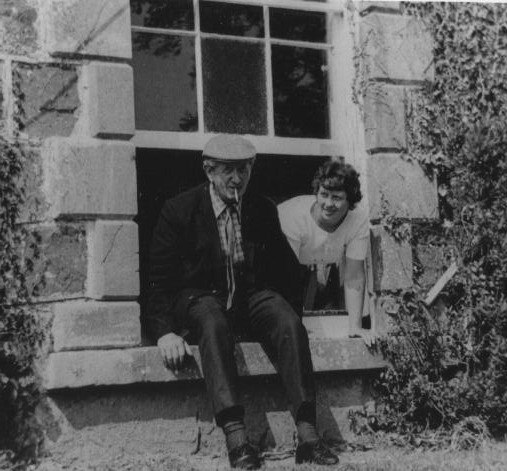
This Book is dedicated to
Daniel Owen Daniel & Rose Bliss
Giving So Many Happy Memories
© Janet Joel
ISBN 0 9533044 0 X
License to use & Copyright Notice
This site is owned and operated by Janet Joel. All online materials including photos, information, information details, programmes, online graphics may not be copied, reproduced, republished, uploaded, posted via e-mail, transmitted, or distributed in any way unless otherwise stated or a written permission has been granted by me.
For purposes of this Agreement, the use of any such material on any other Domain, Sub-domain, Web Pages or networked computer environment is prohibited. All trademarks, service marks and trade names are proprietary to Janet Joel.
The intellectual property rights of the pictures, concepts and designs are owned by http://nanteoshisotry.co.uk and Janet Joel. You may download and print for your personal and non-commercial purposes. Any actions such as removing the copyright notice, modifying the pictures in any way, republishing and reproducing for commercial purposes would be considered as violation of the owner's copyright.
Privacy Policy
Janet Joel and http://nanteoshistory.co.uk endeavors to provide a Safe Surfing and family friendly Environment for you and your children. We therefore, endeavour to safeguard your personal information and your children's personal information. We do not sell, share, or make any of your information available publicly intentionally.
Disclaimer
Whilst we have taken all reasonable steps to ensure that the information contained on this web site is accurate, we cannot accept liability for any inaccuracies, which subsequently come to light.
As we are a Internet service provider, therefore, you must understand that your entry to our web site is out of your own free will. Therefore, your decision of using of our facilities and or downloading any of our downloadable items is entirely out of your own free will and at your own risk.
Whilst we have taken all the reasonable steps to ensure that all the services we are providing are in good working order and virus free, we however, cannot be held responsible directly or indirectly, for any damage or loss of data through hardware or software incompatibility, unexpected virus infection or any other reasons that are beyond our control.
Further Information
E-mail: Janjoeluk@yahoo.co.uk
